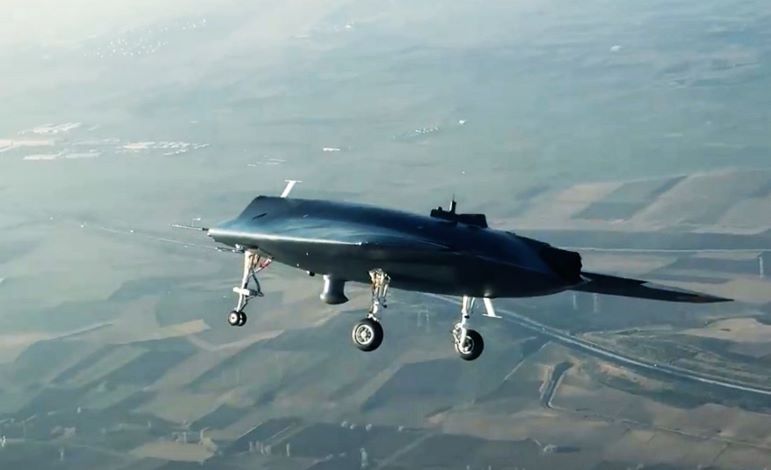Turkish home-made stealth drone performs maiden flight
Turkey has achieved a remarkable feat in the field of unmanned aerial vehicles (UAVs) by successfully flying its first home-made stealth flying-wing drone, the ANKA-3.
The ANKA-3. is a home-grown project by Turkish Aircraft Industries (TAI) that aims to provide a versatile and survivable platform for various combat missions.
The drone made its maiden flight, which was shared on X (formerly Twitter), and stayed in the air for one hour and 10 minutes. It reached an altitude of 8,000 feet and a speed of 150 knots, escorted by a TAI Hürkuş turboprop trainer. The drone is powered by a turbofan engine and has a wingspan of 20 meters.
Turkish President Tayyip Erdogan Erdoğan expressed optimism about the drone’s potential contributions on X, formerly Twitter (translated):
“Our unmanned warplane ANKA-3, developed by TAI, completed its first flight today. Hopefully, our aircraft will make a strong contribution to the defence of our country with its advanced technologies, design, and features.”
TUSAŞ tarafından geliştirilen insansız savaş uçağımız Anka III, bugün ilk uçuşunu başarıyla gerçekleştirdi. İnşallah uçağımız, sahip olduğu gelişmiş teknolojilerle, tasarımıyla ve özellikleriyle ülkemizin savunmasına çok güçlü bir katkı sağlayacak.
pic.twitter.com/ElZaSoNRVo
— Recep Tayyip Erdoğan (@RTErdogan) December 28, 2023
The debut of the new generation of air combat fighters marks the latest significant advancement in Turkish defence capabilities, showcasing the nation’s commitment to indigenous technological development in combat drones.
The drone will be capable of performing different missions, such as reconnaissance, surveillance, and intelligence, with air-ground munitions, air-to-air ammunition, and radar systems. It will be able to perform many tasks, such as operation and communication relay, together with other friendly elements.
The ANKA-3 is designed to have low-observable characteristics, such as a flying wing shape, internal weapons bays, and a possible low-observable exhaust nozzle in the future. It can carry a variety of weapons, including the U.S.-made Mk 82 500-pound bomb and Small Diameter Bomb, as well as the Turkish-made SOM-J standoff missile. The drone has six external hardpoints and two internal bays, with a total payload capacity of 4,400 pounds.
The Anka-3 achieved a speed of 150 knots and also performed a runway overshoot test during the inaugural flight early on Thursday, TAI said.
Also Read: Japan’s SLIM moon lander enters lunar orbit
It features similar avionic architecture and ground control stations to those of the Anka and Anka-2 unmanned combat aerial vehicles, also developed by TAI.
It has neither horizontal nor vertical tails, a design that officials say will enable it to operate covertly without detection. It will also feature a high-speed transfer capability, allowing quick deployment to remote areas.

The Anka-3 is expected to be capable of flying at a service altitude of up to 40,000 feet and withstand flight for up to 10 hours at 30,000 feet.
It will have a maximum takeoff weight of 6,500 kilograms (14,330.05 pounds) and a practical payload capacity of 1,200 kilograms.
Anka-3’s capacity will enable the integration of a wide range of options, from commonly used munitions in current UAVs to larger munitions such as SOM-J, MK-82 and bunker-busting bombs.
“We now have a UAV in the sky that the enemy cannot see but can see the enemy,” said Temel Kotil, general manager of TUSAŞ.
The drone is also part of Turkey’s ambitious plan to develop a stealth fighter, the TF-X, which is expected to fly soon. The ANKA-3 and the TF-X could work together as a team, with the drone acting as a loyal wingman or a decoy for the manned aircraft.
Turkey is not the only country that is pursuing flying-wing drones. China has several models, such as the GJ-11 Sharp Sword, and Russia has the Okhotnik-B UCAV. These drones have also undergone flight testing and are likely to enter service shortly. However, the United States does not have a similar program, at least not one that is publicly disclosed.



Comments are closed.